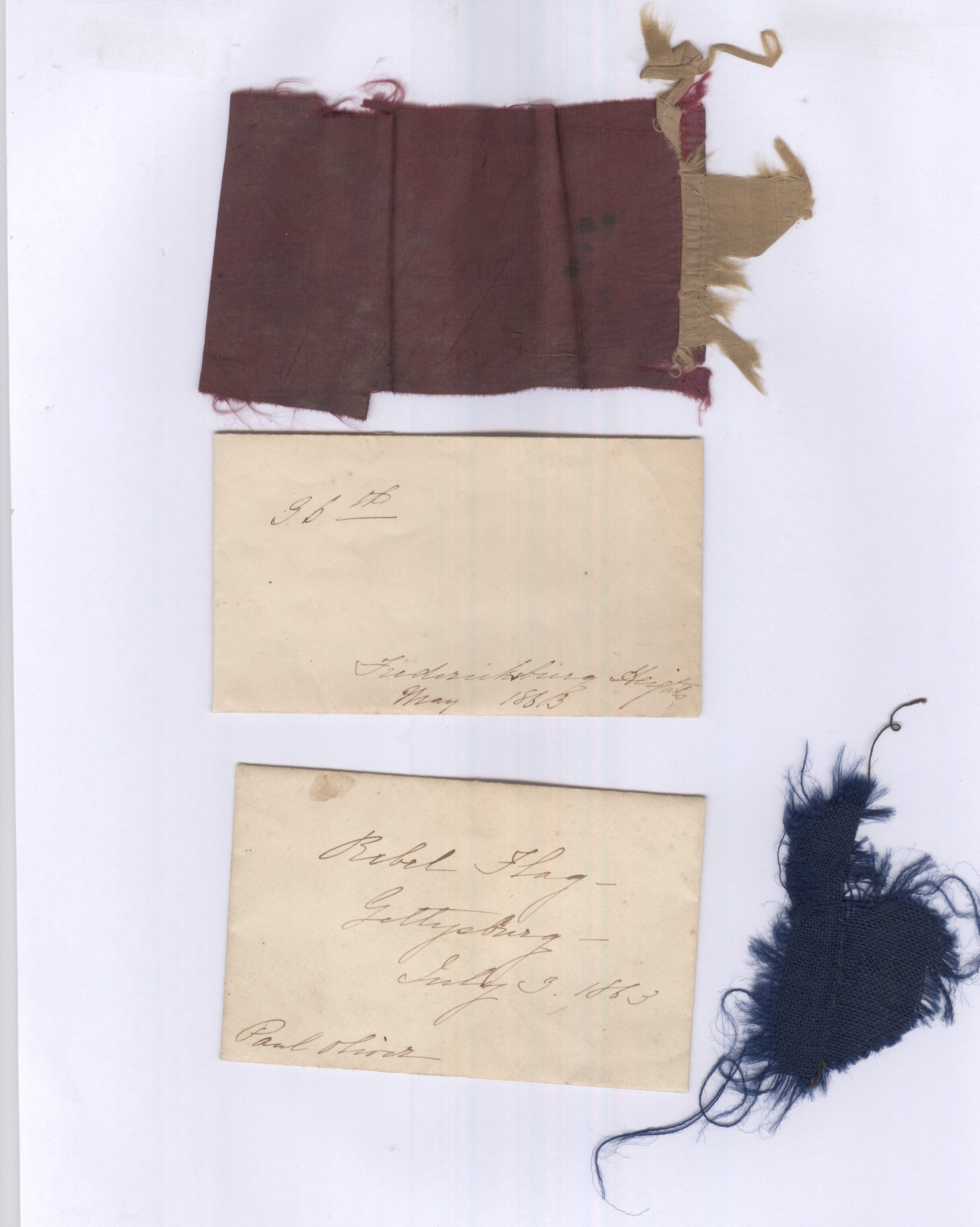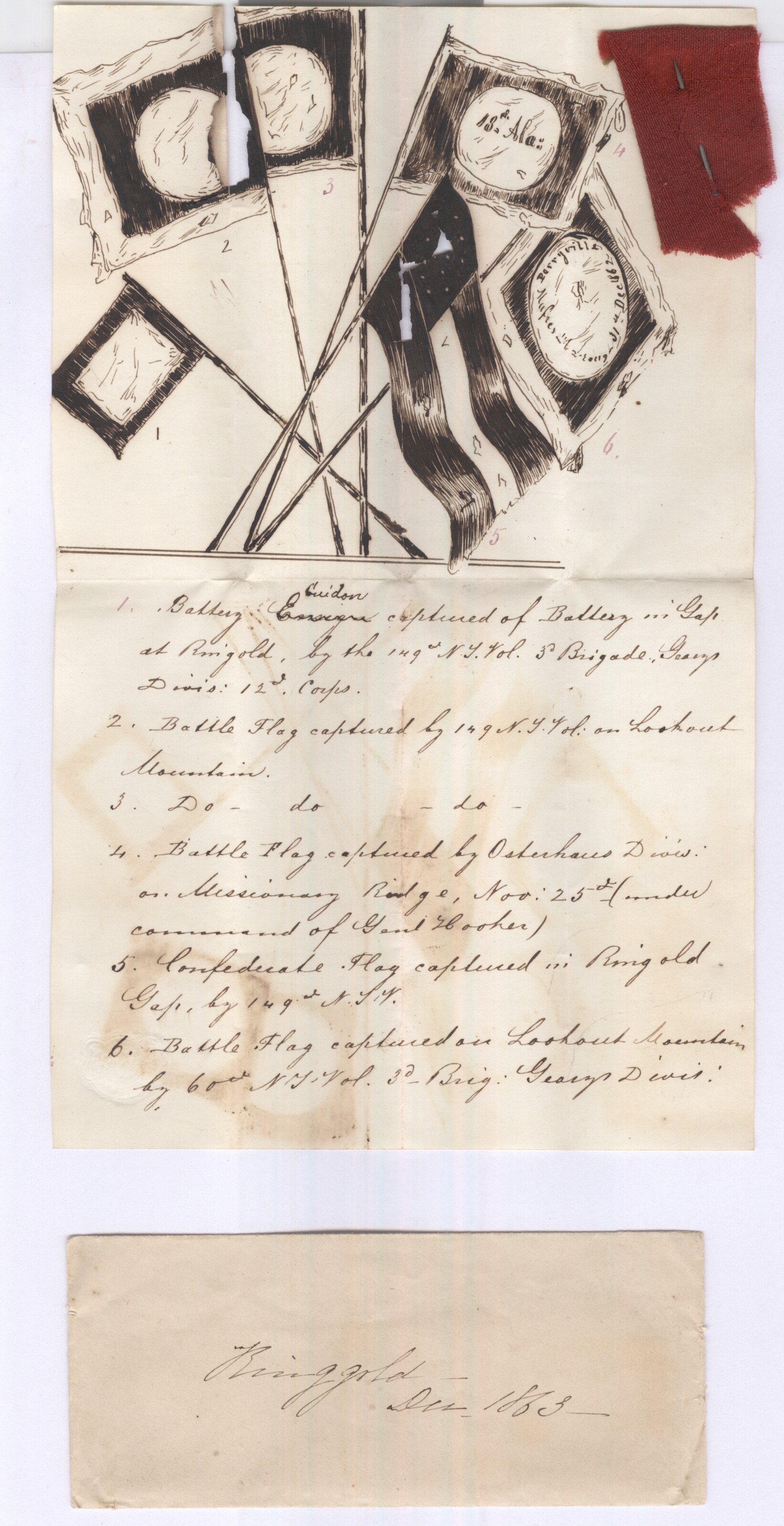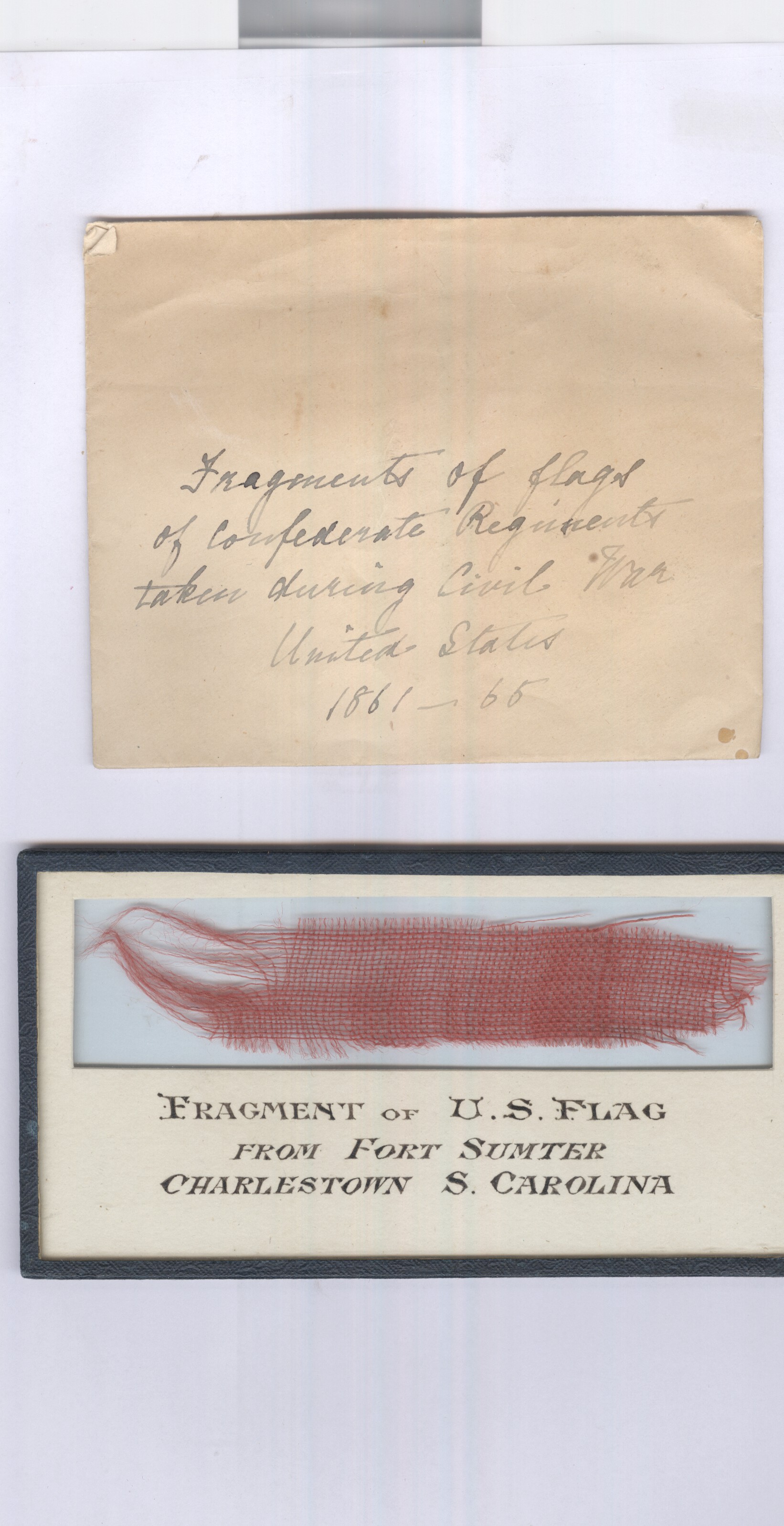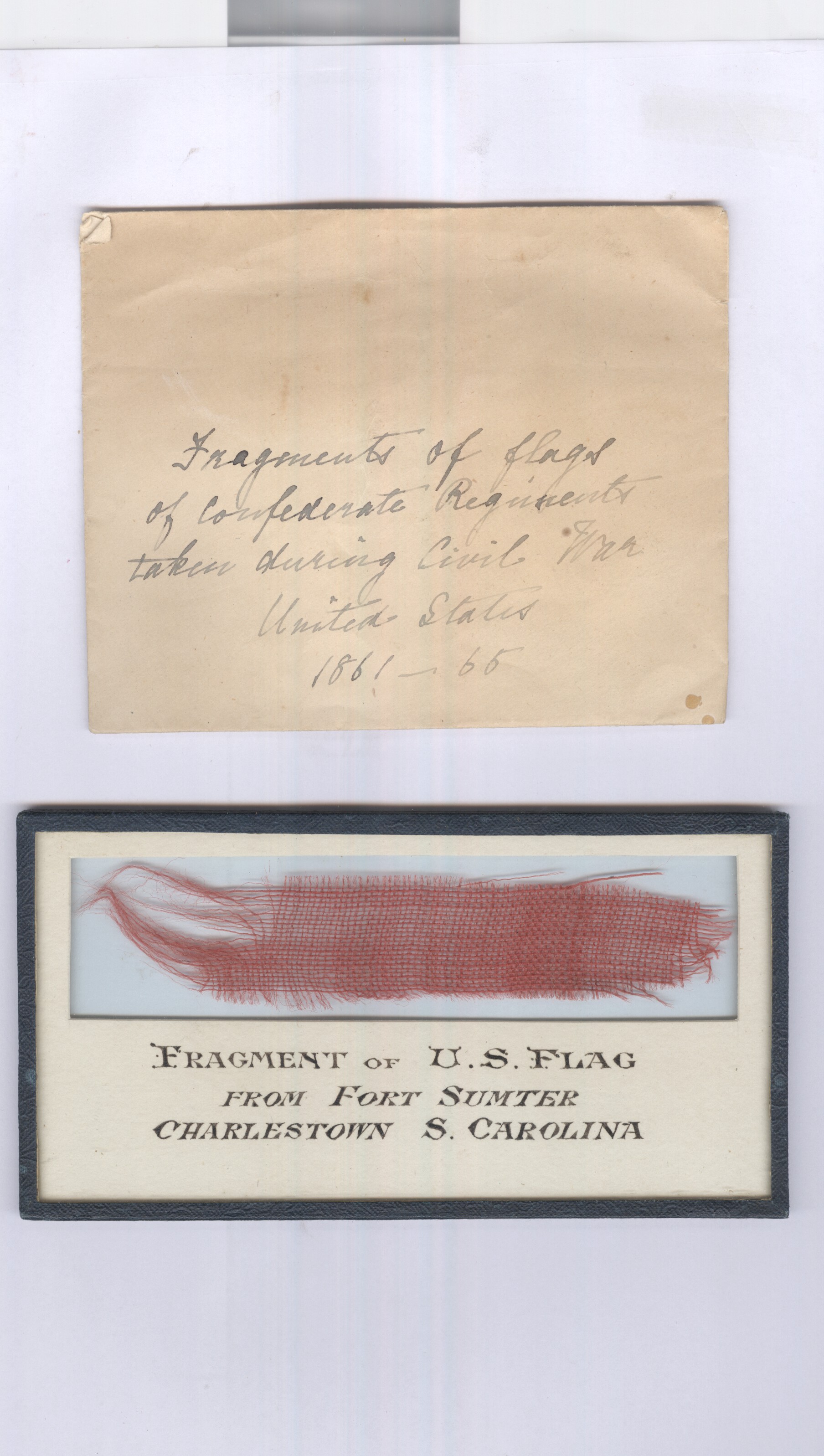
FRAGMENTS OF CAPTURED CIVIL WAR FLAGS
OLIVER
(Paul Ambrose, 1831-1912, American Explosives Inventor)
Extraordinary collection of fragments of flags from the Civil War
in envelopes and with an illustrated letter, the letter is headed with a hand drawn picture of 6 flags with the annotations underneath “1. Battery Guidon captured of Battery in Gap at Ringold by the 149th N.Y. Vol & Brigade Geary Divis 12th Corps. 2. Battle Flag captured by 149 N.Y. Vol on Lookout Mountain 3. Do - Do - Do 4. Battle Flag captured by Osterhaus Divis on Missionary Ridge, Nov 25th (under command of Genl Hooker) 5. Confederate Flag captured in Ringold Gap by 149th N.Y.V. 6. Battle Flag captured on Lookout Mountain by 60the N.Y. Vol. 3d Brig. Geary’s Divis.”, with a small red piece of flag with its envelope attached to the letter annotated in Oliver’s hand “Ringold. Dec 1863”, 1 side 8vo., no date, together with a further two envelopes each enclosing a small piece of flag the first, a blue fragment, is annotated “Rebel Flag - Gettysburg, 9th July 1863” signed in the corner and the other, a red fragment, is annotated “96th. Fredericksburg Heights May 1863”, together with a further fragment of red flag in a small glass frame annotated “Fragment of U.S. Flag from Fort Sumter Charlestown S. Carolina” and on the verso “Surrendered to Confederats April 13 1861”
Oliver was an American Civil War Union Army captain and staff officer who was appointed to the brevet grade of brigadier general and Medal of Honor recipient. In January 1862, Oliver joined the 12th New York Volunteer Infantry as a second lieutenant. During the war, he served as an aide to no fewer than four generals, including Daniel Butterfield, George Meade, Joseph Hooker and Gouverneur K. Warren. While he accepted a promotion to captain in April 1864, he declined further promotions. On March 8, 1865, President Abraham Lincoln nominated Oliver for appointment as a brevet brigadier general to rank from March 8, 1865 and the U.S. Senate confirmed the appointment on March 10, 1865. Oliver resigned his commission on May 6, 1865. Oliver was an inventor and powder manufacturer after the Civil War.
The Battle of Ringgold Gap was fought November 27, 1863, in northwest Georgia during the Chattanooga Campaign of the American Civil War. The Confederate victory by Maj. Gen. Patrick Cleburne gave the artillery and wagon trains of the Army of Tennessee safe passage to retreat through the "Ringgold Gap" mountain pass and caused high Federal casualties.
The 149th Pennsylvania Infantry, also known as the 2nd Bucktail Regiment, volunteered during the American Civil War and served a 3-year term from August 1862 to June 1865. The Regiment is most noted for its service and sacrifice on July 1, 1863, at the Battle of Gettysburg. One source reports 53 soldiers killed, 172 wounded, and 111 missing or captured out of 450 soldiers engaged for a total casualty rate of 74.7% at the epic Battle.
The Battle of Lookout Mountain was fought November 24, 1863, as part of the Chattanooga Campaign of the American Civil War. Union forces under Maj. Gen. Joseph Hooker assaulted Lookout Mountain, Chattanooga, Tennessee, and defeated Confederate forces commanded by Maj. Gen. Carter L. Stevenson.
Peter Joseph Osterhaus (1823-1917) was Union Army general in the American Civil War and later served as a diplomat. At the outbreak of the Civil War Osterhaus was appointed a major of the 2nd Missouri Volunteer Infantry and during the first year of the war was employed in Missouri and Arkansas, where he took a conspicuous part in the Battle of Wilson's Creek and Battle of Pea Ridge.
Joseph Hooker (1814-1879) was a career United States Army officer, achieving the rank of major general in the Union Army during the American Civil War. Although he served throughout the war, usually with distinction, Hooker is best remembered for his stunning defeat by Confederate General Robert E. Lee at the Battle of Chancellorsville in 1863.
The Battle of Gettysburg was fought July 1st to 3rd 1863, in and around the town of Gettysburg. The battle involved the largest number of casualties of the entire war and is often described as the war's turning point. Union Maj. Gen. George Meade's Army of the Potomac defeated attacks by Confederate Gen. Robert E. Lee's Army of Northern Virginia, halting Lee's invasion of the North.
The Battle of Fredericksburg was fought December 11th to15th 1862, in and around Fredericksburg, Virginia, between General Robert E. Lee's Confederate Army of Northern Virginia and the Union Army of the Potomac, commanded by Major General Ambrose Burnside. The Union Army's futile frontal attacks on December 13th against entrenched Confederate defenders on the heights behind the city are remembered as one of the most one-sided battles of the war, with Union casualties more than three times as heavy as those suffered by the Confederates. A visitor to the battlefield described the battle to U.S. President Abraham Lincoln as a "butchery."
The Battle of Fort Sumter (April 12th to13th, 1861) was the bombardment of Fort Sumter near Charleston, South Carolina by the Confederate States Army, and the return gunfire and subsequent surrender by the United States Army that started the American Civil War.
Item Date:
0
Stock No:
39234




<< Back